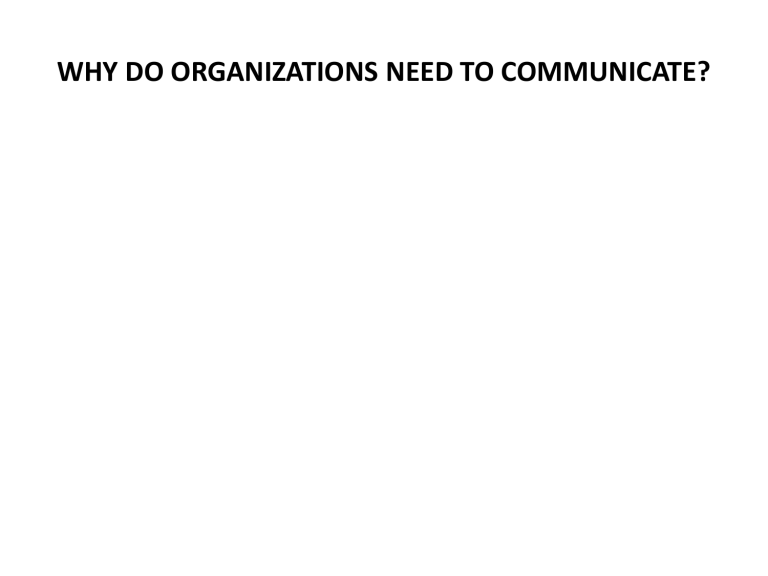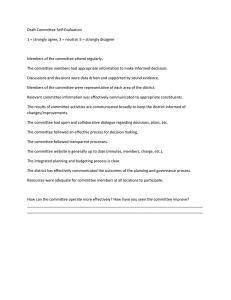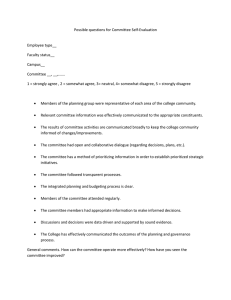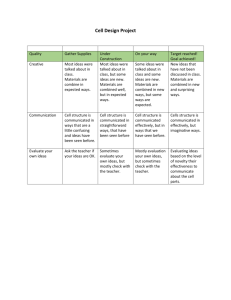Internal Communication Strategy in Organizations
advertisement

WHY DO ORGANIZATIONS NEED TO COMMUNICATE? WHY DO ORGANIZATION NEED TO COMMUNICATION INTERNALLY? IS IT IMPORTANT? INTERNAL COMMUNICATION INTERNAL COMMUNICATIONS (IC)… …is the function responsible for effective communication among participants within an organization. ESSENTIAL CONSIDERATIONS… • Is there an existing communication process? If yes, how can the new process be integrated with or replace the old? • What information currently exists and how is it managed and organized? • Who needs to regularly communicate information in the business? • Who currently creates and disseminates information? • Who will be responsible for and manage the accountability of the communication strategy going forward? • What needs to be communicated? Remember that different messages may require different mediums. ESSENTIAL CONSIDERATIONS…CONTD. • Who does information need to be communicated to? Who has a vested interest in receiving or giving information? • When does information need to be communicated? • What is the intended culture that is needed or wanted? • What internal communication tools or mediums are already available? • How will each medium be used? • What is the required frequency? • Are there any factors that will impact the success or failure (i.e. people, time, budget, available tools, linguistic or cultural differences, interdependencies, etc.)? If so, develop strategies to address these factors/risks. FUNCTION PERFORMED… • Role of 'internal marketing' (i.e., attempting to win participants over to the management vision of the organization); • Perform a 'logistical' service as channel manager; • Act principally as strategic adviser. OBJECTIVES OF THE INTERNAL COMMUNICATION STRATEGY • foster a strong communication culture within the business • create a two-way flow of information that moves information from the top to the bottom and then moves feedback back up to the top. • filter the message(s) coming from upper management down to all employees • provide employees with a better understanding of the purpose, goals, and directions of the business. • Be a method in place for feedback from the employees to be delivered back to upper management FLUID COMMUNICATION IN BOTH DIRECTIONS IS KEY TO THE SUCCESS OF THE INTERNAL COMMUNICATION STRATEGY. GUIDELINES FOR DEVELOPING A IC STRATEGY • Align with and support the business objectives and external communication strategies • Design two-way process to respect and take into account everyone’s views • Recognize that messages are not always tangible • Communicate consistent messages Key elements…. • Enable a two-way flow of information between employees and management. • Be integrated with the overall business strategy. • Have a long-term focus. • Communicate clear values and goals. • Be comprehensive. • Utilize appropriate methods of communication. • Have consistent messages. • Never be condescending in nature. • Involve the management team commitment to reinforcing perceptions delivered via the communication strategy — management needs to “walk the talk.” TOOLS Direct \ Tangible… – Newsletter (online or printed newsletters) – multi-media approach. – Intranet – email bulletins TOOLS • Indirect / Intangibles (subtle and/or non-verbal) – way that the business treats its clients, – way it operates, – Way the decisions made by management. • Specimen: – – – – – – – policies and procedures. employee training performance appraisals team or individual work meetings in slogans on internal billboards or notice boards, company recognition programs. DEVELOPING INTERNAL COMMUNICATION STRATEGY • • • • • • • • • • • • • • Determine how information has been communicated in the past. How and why did that process have limitations? Agree on what happens next. How will the process be managed? Who is responsible for what? Set measurable communication objectives that are aligned with business goals. Engage management in the internal communication strategy initiative and secure their support. Encourage enthusiasm and commitment. Engage employees in all areas of the business. Identify key spokespersons and ensure they are properly informed and supportive of the strategy. These communication “holders” will be imperative to feeding information to the communication process in a timely manner. DEVELOPING INTERNAL COMMUNICATION STRATEGY…CONTD. • Develop processes and schedules to support and measure the effectiveness of the strategy. • Determine what mediums are best suited to the internal communication strategy goals. Adapt the medium(s) to the human and financial resources available. • Develop content writing protocols to ensure consistency from all content providers. • Develop a plan for building employee awareness of the importance of the new internal communication strategy. • Following implementation, monitor and review all employee and management feedback regularly. Be prepared to change or adjust the plan or process as necessary. THROUGH AN EFFECTIVE IC STRATEGY… • Create … – a workplace where all employees are informed and working toward the same goals through clear direction for everyday activity. – a common vision and reduce the capacity for workplace conflict by reducing ambiguity of messages or ideas. • Encourage … – the formation of a supportive and knowledge sharing work culture as everyone works by the same rules. – a sense of belonging to the whole by feeling privy to what is going on. • Enable … – all employees to be able to articulate the business’ mission, values, and goals and support those business objectives. – the review of business activity and provide the channels to measure future success. THROUGH AN EFFECTIVE IC STRATEGY…contd.. • Improve employee understanding of and response to each other’s needs. • Empower employees to make better and more informed daily decisions that are aligned with meeting long-term business objectives. • Promote a clear, shared understanding of change processes and gain commitment for change as well as counteract unnecessary employee anxiety about change. • Ensure the efficient use of resources by prioritizing conflicting demands. • Motivate better performance by linking individual and team efforts with a systems-thinking “big picture” approach that effectively breaks down personal or departmental fiefdoms Q&A Further reading: • Internal Communication: The Neglected Strategy http://score-tvc.org/FAQ/Internal%20Communication%20Strategy.pdf • Trends in Internal Communications: Steering Dialogue through Change, Crises and Everyday Workflow http://www.internal-communication.eu/_files/brochure.pdf • Internal Communication: Toolkit http://www.aswat.com/files/CIVICUS%20-%20Internal%20Communication.pdf Assignment • As a manager, what do you foresee as your major challenges in managing communication at your organization, at individual and organization level. Keeping in view, available literature (research and books) explore and critique on possible issues and suggest methods for handling them. • (Limit: Between 500 to 1,000 word). • 1 inch margin on all four sides and 1.5 line spacing. • References are a must.



